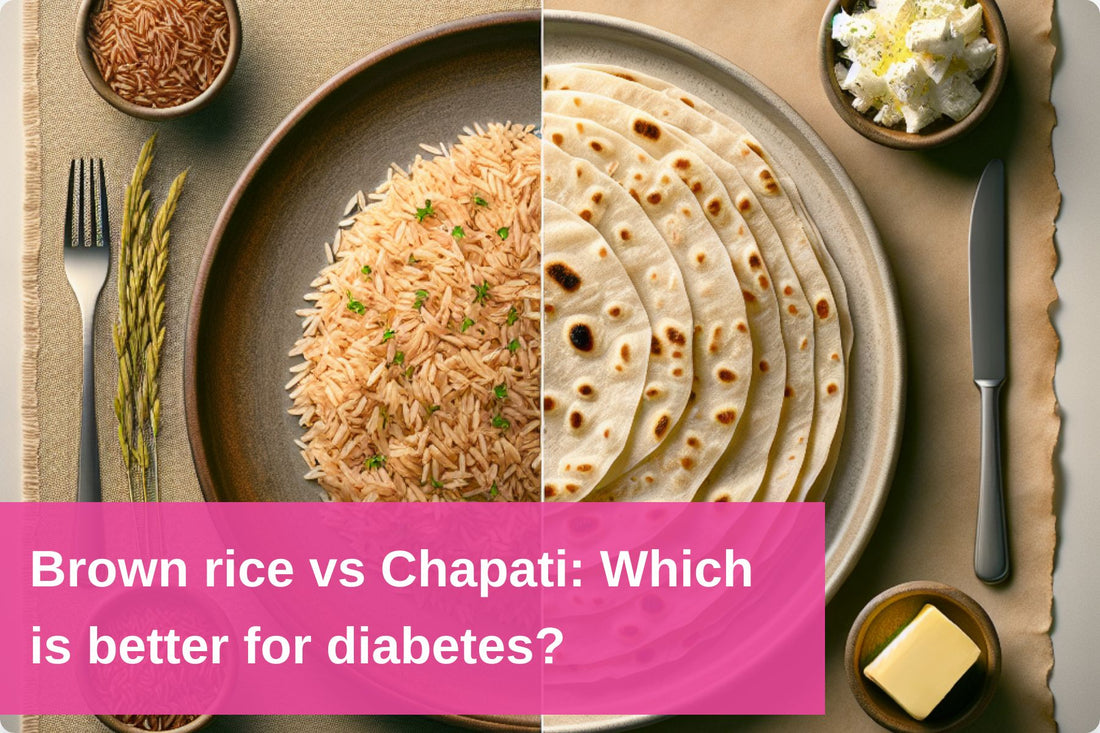When it comes to managing diabetes, what you eat plays a big role in keeping your blood sugar levels in check. One common debate is whether to choose brown rice or chapati as part of your diet. Both are basic foods, and understanding their effects is important for people dealing with diabetes.
Brown rice is unprocessed and has lots of fiber, making it a popular choice for controlling sugar levels. On the other hand, chapati, a flatbread, is known for being versatile in meals. This isn't just about taste; it's about making choices that can benefit your health.
Let's talk about the glycemic index, which tells us how different foods impact blood sugar levels. But instead of just throwing numbers around, we'll look at the nutrition in brown rice and chapati. We want to move past the usual "good" or "bad" labels and provide helpful insights. It's not about strict diets; it's about giving people with diabetes the knowledge to make smart and personalized choices.
Whether you're already into healthy eating or just starting to manage diabetes, what you eat every day makes a difference. Join us as we compare brown rice and chapati, uncovering the nutrition details that matter for those dealing with diabetes.
Understanding the Glycemic Index
The Glycemic Index (GI) is an important factor for people handling diabetes. It's not just a number; it helps you understand how different carbs affect your blood sugar. In simple terms, the GI tells us how fast a certain food raises blood sugar after you eat it.
Let's focus on brown rice and chapati. Brown rice usually has a lower GI than chapati, meaning it leads to a slower and more steady increase in blood sugar levels. This gradual effect is good for those trying to keep their glucose levels stable all day.
Now, let's talk numbers. Brown rice is generally in the medium-GI category, while chapati varies based on the flour. Whole wheat chapati usually has a lower GI than those made with refined flours. Knowing these details helps you make smart choices that match your health goals.
Why does the GI matter? It helps people with diabetes handle their blood sugar well. Picking foods with a lower GI can improve glucose control, reducing the chances of sudden spikes and crashes.
In a nutshell, the GI isn't a complicated idea just for experts. It's a useful tool for everyday choices. When deciding between brown rice and chapati, understanding the GI can guide you to options that support your diabetes management. It's not just about numbers; it's about choosing what works best for you.
Nutritional Analysis: Brown Rice vs. Chapati
Let's dig into the details of nutrition – a crucial aspect when comparing brown rice and chapati, especially for those managing diabetes.
Carbohydrates: Brown rice is often praised for its complex carbs, giving a steady energy boost. Chapati, a whole grain flatbread, also packs a punch in the carb department. The key is understanding the carbs. Brown rice, with its fiber-rich layer, slows down digestion, leading to a gentler impact on blood sugar.
Fiber: Both brown rice and chapati add to your daily fiber intake, which helps manage blood sugar. Brown rice, with more fiber, keeps you feeling full, possibly aiding in weight control – a good thing for diabetes.
Vitamins and Minerals: Brown rice is loaded with vital vitamins and minerals like B vitamins, manganese, and selenium. These nutrients play diverse roles in overall health. Chapati, while not as rich, still adds to your daily needs. It's not just about diabetes; it's about nourishing your body overall.
Impact on Blood Sugar Levels: Now, let's connect the dots. The nutrients in both brown rice and chapati affect how they interact with blood sugar. The slow carbs in brown rice and its fiber contribute to a steady glucose response. Chapati, with its whole-grain goodness, supports this stability. It's not about picking one over the other; it's about understanding and including both in a balanced diet.
In essence, the nutrition comparison isn't about declaring a winner; it's about recognizing each one's strengths. Brown rice and chapati can coexist in a diabetes-friendly diet, bringing their unique benefits to your overall well-being.
Red Rice vs. Brown Rice: Diabetes Perspective
Let's talk about red rice and brown rice and how they affect people with diabetes.
Why Brown Rice is Good: Brown rice is a popular choice for healthy eating. It's not processed much, and for those with diabetes, it's great because it has lots of fiber and carbs that don't raise blood sugar too quickly. The outer layer of the rice, called bran, is full of good stuff for your body.
Why Red Rice is Also Good, but with a Caution: Now, let's shine a light on red rice. It's full of good things like antioxidants, vitamins, and minerals. But for people with diabetes, it might affect blood sugar a bit more than brown rice. It has what's called a higher glycemic index.
What to Watch Out for with Red Rice: Even though red rice isn't terrible for blood sugar, it's still wise to be careful. It's better than some other processed grains, but it's important not to eat too much. Controlling how much you eat is crucial when adding red rice to a diabetes-friendly diet.
Compared with Chapati: Now, let's think about chapati, a flatbread. Both brown rice and red rice have good things, but chapati is also great with whole grains. The key is to mix things up and not rely on just one. By combining these foods wisely, you can have a well-rounded diet that's good for diabetes.
In conclusion, it's not about saying one rice is better than the other. It's about knowing what's good in each and finding a balance. Whether you like the earthy taste of brown rice, the colorful red rice, or the familiar chapati, you can make choices that help your health goals and enjoy a diverse and healthy menu.
How Much Brown Rice Can a Diabetic Eat?
Controlling How Much Brown Rice to Eat with Diabetes:
To make the right choices with brown rice while managing diabetes, it's important to focus on how much you eat. Here's a simple guide:
- Watch Your Portions: The key is not to eat too much brown rice at once. If you have diabetes, a good serving is around ½ to 1 cup. Keep an eye on the carbs to keep your energy stable and avoid big jumps in your blood sugar levels.
- Mix it Up: A smart move is to pair your brown rice with veggies and lean proteins. This not only makes your meal more nutritious but also helps control its impact on your blood sugar. Veggies bring fiber and nutrients, while proteins keep you feeling full and prevent overeating rice.
-
Plan Your Meals: Think ahead when adding brown rice to your diabetes-friendly meals. It's better to spread your rice intake throughout the day instead of having a lot at once. This way, you keep a steady amount of carbs in your system, which helps manage your blood sugar.
For instance, if you like rice with lunch, go for a smaller portion. Add in a mix of colorful veggies and a protein source like grilled chicken or tofu. This not only makes your plate look good but also gives your body a range of nutrients for overall health.
Remember, managing diabetes is more about making clever choices than strict limitations. Try different portion sizes, see how your body reacts, and adjust what you eat accordingly. It's not just about how much brown rice you can have; it's about putting together a balanced meal that fits your health goals.
Brown Rice VS Chapati: Best of both worlds
In conclusion, we've looked into the brown rice versus chapati debate, focusing on how it affects people managing diabetes. Let's break it down:
Main Points:
- Glycemic Index Exploration: We explored how brown rice and chapati impact blood sugar levels, considering the glycemic index.
- Nutritional Analysis: Both brown rice and chapati offer unique benefits. A balanced diet is essential, and we extended the comparison to include red rice for those wanting variety.
- Portion Control Advice: Practical tips were given on incorporating brown rice wisely into a diabetes-friendly meal plan.
Final Suggestions: In the brown rice versus chapati debate, there's no one-size-fits-all answer. Both can be part of a diabetes-friendly diet. Opting for whole grains, whether brown rice or whole wheat chapati, is a smart choice for steady energy and overall health.
Encouragement for Personalized Choices: Rather than sticking to a strict diet, the focus is on embracing personalized choices. Understand how your body reacts to different foods, experiment with portion sizes, and create a diet that aligns with your health goals. Variety in your plate is key to a well-rounded and enjoyable approach to managing diabetes.
Consultation with Healthcare Professionals: Seeking advice from healthcare professionals is crucial. They provide personalized recommendations based on individual health conditions and preferences, ensuring your dietary choices align with your health objectives.
Essence of the Debate: The brown rice versus chapati debate is not a battleground but an opportunity to create a colorful and nutritious dietary landscape. Armed with knowledge, remember that your choices matter. Craft a diet that supports your health and delights your taste buds. Cheers to informed choices, balanced plates, and a thriving journey in managing diabetes!
References
This Blog post is an initiative by DiabeSmart, to provide accurate and Nutritionist / Doctor approved information related to Diabetes. DiabeSmart is India's first Food brand designed specifically for Diabetics, that has been clinically tested on Diabetics and Pre-Diabetics to deliver 55% - 70% lower Sugar spikes. DiabeSmart is part of Lo! Foods - India's leading brand for Everyday Functional Health foods.















